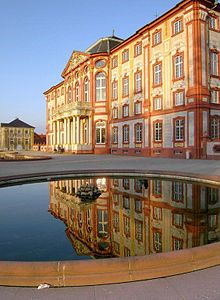Slab sandstone
As plate sandstone are commonly known and summarized in certain occupations several types of sandstone, which in many quarries in central and southern Baden-Wuerttemberg at the Black Forest are broken down. They originated in the Upper Buntsandstein . The name slab sandstone comes from the fact that more or less flat slabs of about 6 cm thick and more can be obtained from this material. In 2008 two types of sandstone were being mined, the Loßburger and the Freudenstädter sandstone .
Occurrence
A deposit with a thickness of 40 meters is located south of the Kraichgau in the district of Malsch near Ettlingen , Königsbach-Stein and Weingarten in Baden-Württemberg . On the eastern edge of the Black Forest near Bad Wildbad , Altensteig , Freudenstadt , Schiltach and from Schramberg to Villingen there is another with a thickness of 35 to 40 meters, there are also isolated occurrences between Offenburg and Lahr , on the Lorettoberg near Freiburg im Breisgau and between Schopfheim and Loerrach .
Slab sandstone occurs in particular thickness and quality in the Albtal , Pfinztal , Murg - and Enztal valleys . The Loßburg sandstone, which comes from Loßburg near Freudenstadt and is still used to this day, was particularly popular .
Rock description and use
These sandstones are fine-grained and fine-pored and, due to the geographically extensive area of origin, they are colored differently from reddish to pale red. Since muscovite , the light mica, is stored in layers, it can be split easily. Occasional clay deposits can be found. The weathering resistance is good to moderate, depending on the quarry.
Numerous buildings in the Black Forest are made of slab sandstone, the most famous are the Hirsau Monastery , Bruchsal Castle, Ettlingen Castle and St. Mary's Church and the courtyard of the University of Karlsruhe . The stones of the last three structures mentioned were cut from the Loßburg sandstone.
use
The natural stones are used for monumental structures in structural engineering and bridge construction, level and profiled stone , floor slabs, house bases, troughs, monuments and tombs as well as for floor and wall slabs and filigree stone carving work. In the southern Black Forest, millstones were made from slab sandstone.
Web links
- Images from the slab sandstone quarries (PDF file; 261 kB)
- Weathering behavior of the flat sandstone ( Memento from June 11, 2007 in the Internet Archive )
literature
- W. Dienemann and O. Burre: The usable rocks of Germany and their deposits with the exception of coal, ores and salts, Enke-Verlag, Stuttgart 1929, p. 242f.
- Wolf-Dieter Grimm: picture atlas of important monument rocks of the Federal Republic of Germany. Published by the Bavarian State Office for Monument Preservation, Lipp-Verlag, Munich 1990, ISBN 3-87490-535-7 .

